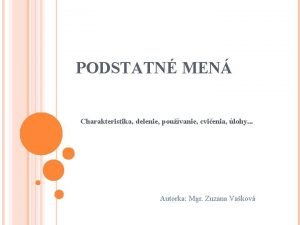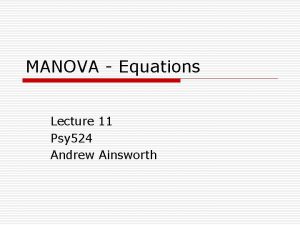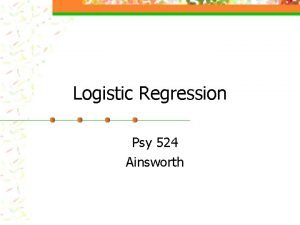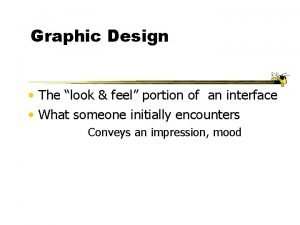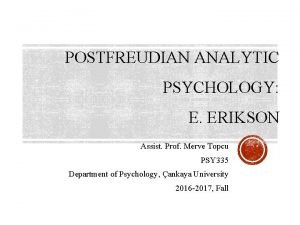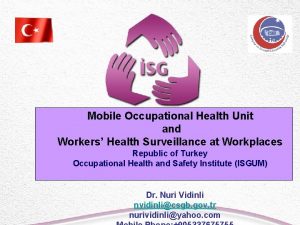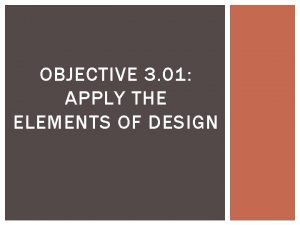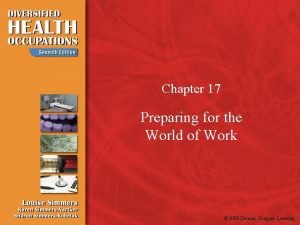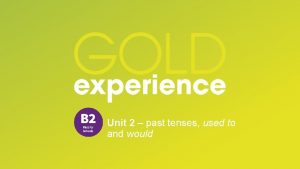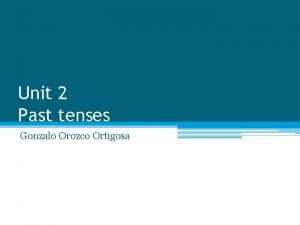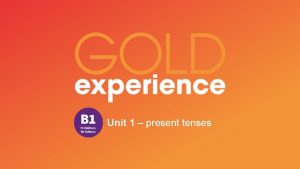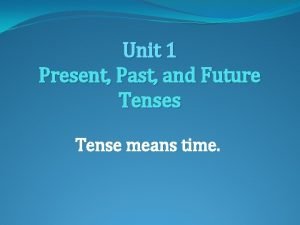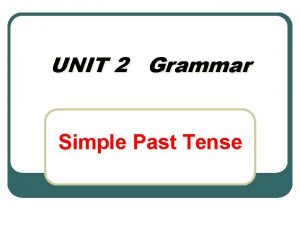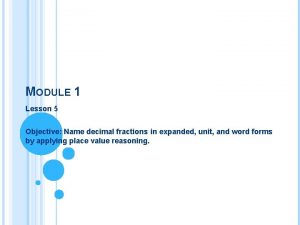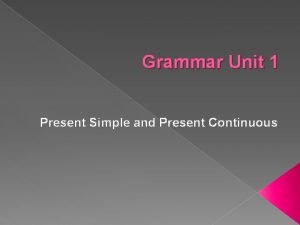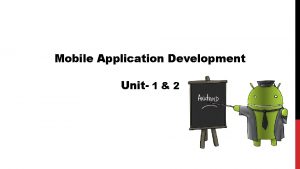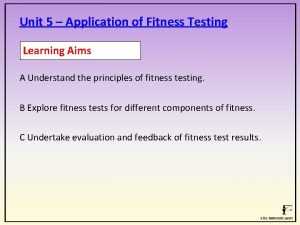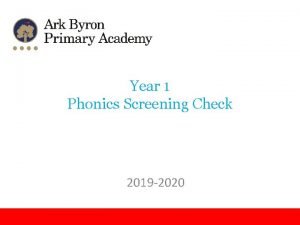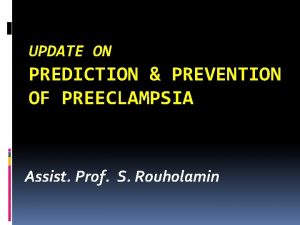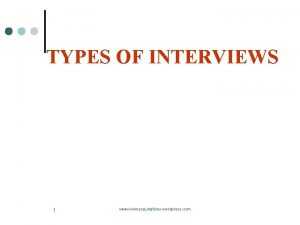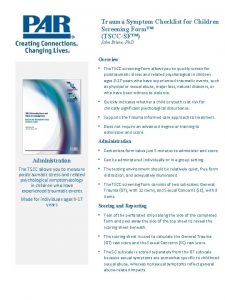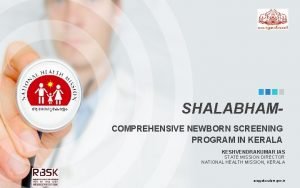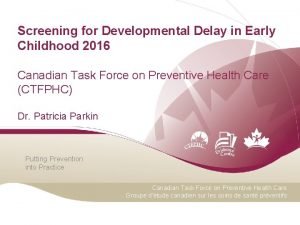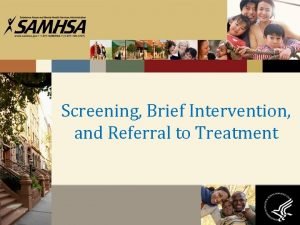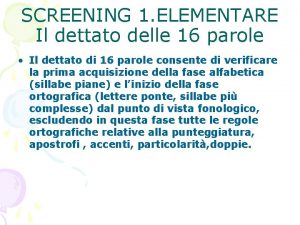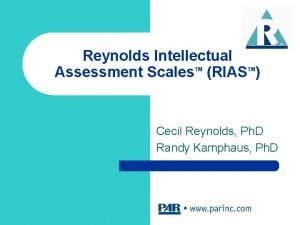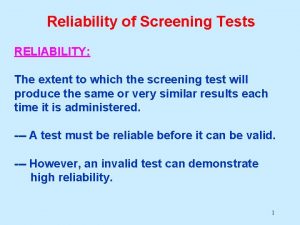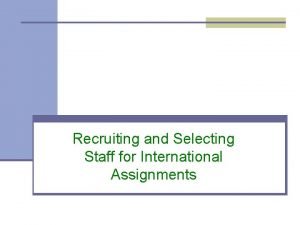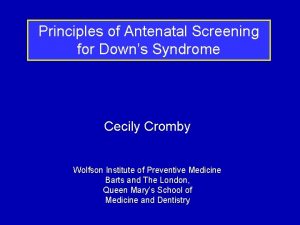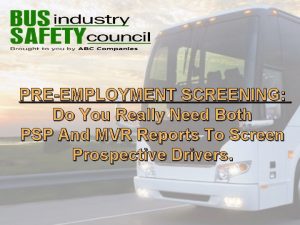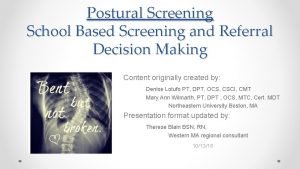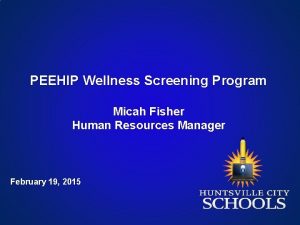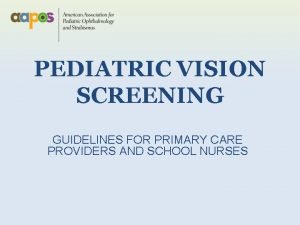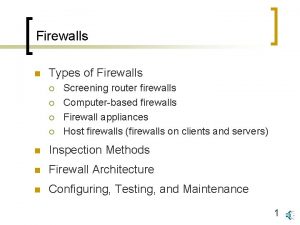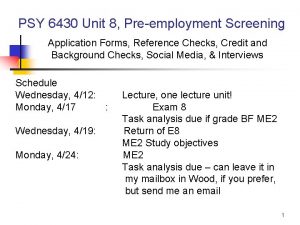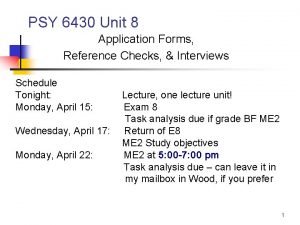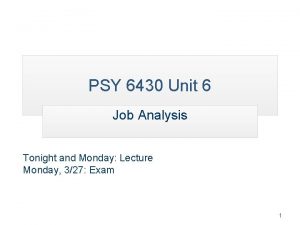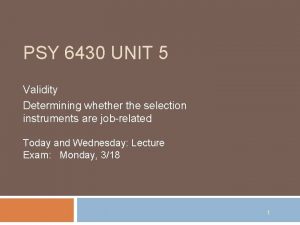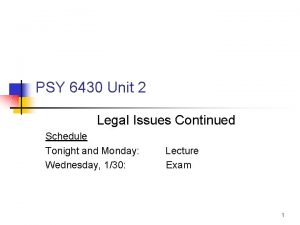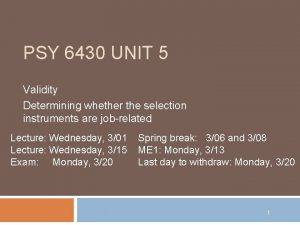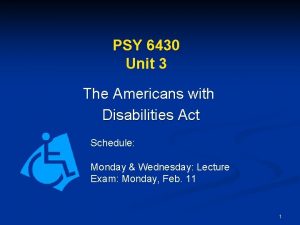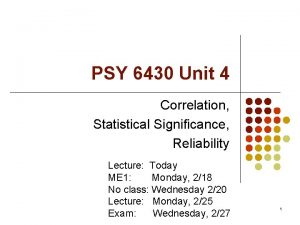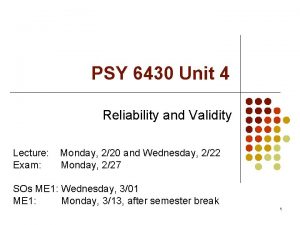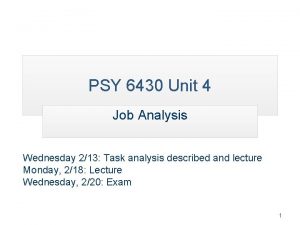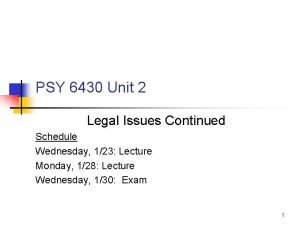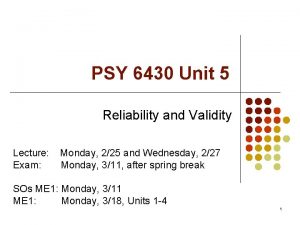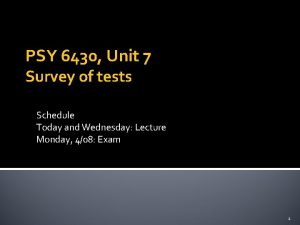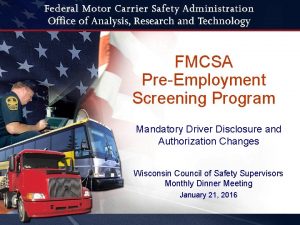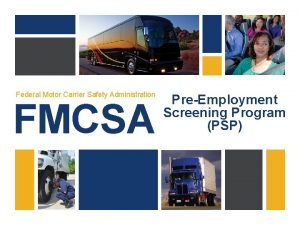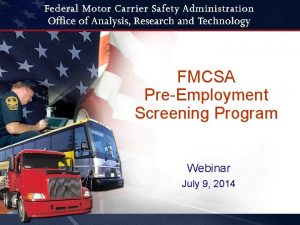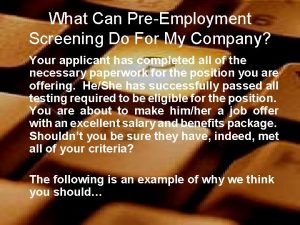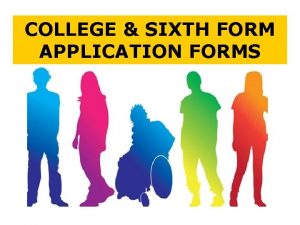PSY 6430 Unit 8 Preemployment Screening Application Forms































































- Slides: 63

PSY 6430 Unit 8, Pre-employment Screening Application Forms, Reference Checks, Social Media, & Interviews Schedule Wednesday, 4/10: Lecture, one lecture this unit!! Monday, 4/15: Exam 8 Wednesday, 4/17: No lecture, return of E 8 ME 2 Study objectives Monday, 4/22: ME 2 Task analysis due – can leave it in my mailbox in Wood, if you prefer, but send me an email 1

Application forms & Biodata assessments n As indicated in SO 1, while I understand that biodata assessments are valid, I have a hard time with them because (also two very serious legal issues): n Invasion of privacy: see questions in Tables 9. 2 and 9. 3 on pages 361 and 362 n n n Particularly given the warning by the authors later in the text that invasion of privacy issues are likely to become more important in the future Adverse impact Also, professionally, the nature of the work force may (and does) change over time and what predicts successful performance for current workers may not at all predict successful performance for “new” generations of workers, particularly given increasing diversity of the workforce (read them; cont. next slide) 2

SO 1: Application & Biodata assessments n n And, research indicates that they don’t add any predictive value over general mental ability tests Schmidt & Hunter’s recommendation, which I completely agree with: Employers would do as well with a readily available mental ability test (save time and money re development) and avoiding biodata inventories 3

SO 2: Falsification of information on resumes and application forms n n n People do falsify information, for positions at all levels of an organization Resume. Doctor. com found that 45% of 1, 000 resumes they reviewed had major misstatements Popular press articles suggest that 1/3 -1/2 of applicants list incorrect employment dates or exaggerate accomplishments NFE: 41% of college students said they included at least one false statement on an application, and 70% said they were willing to do that NFE: 55% of employees, aged 18 -35 (your age!) stated they cold name a person who lied on an application (not really solid data on falsification but. . ) 4

SO 2 this slide NFE: Falsification of information on resumes and application forms n n Your age group is not alone: 40% of executives reported they had lied about their education, 35% had lied about accomplishments or job missions, and 25% had lied about their responsibilities and skills A 2017 survey by Office Team found that reported lying had increased by 25% since their last survey in 2011 Often, folks do not get caught: 46% of hiring managers said that they do not check application/resume information Consequences for lying if caught before hire? Usually none because the person simply won’t be hired; it is too legally complicated/riksy and expensive to tell a person that is why he/she wasn’t hired 5

SO 2, NFE: examples from a 2012 article n n Marilee Jones, Dean of Admissions at MIT did not have any of the degrees she claimed from three universities Kenneth Lonchar, CEO of Veritas Software lied about having an accounting degree Shirley De. Libero, head of Houston Metropolitan Transit Authority, did not have two degrees listed on her resume Michael Brown, head of the Federal Emergency Agency n n n Claimed he was assistant city manger when he was only assistant to the manager with no mgt. responsibilities Claimed he was a professor when he was only a student at a particular university Did not reveal previous employment from which he had been terminated *Bible, J. D. (2012). Lies and damned lies: Some legal implications of resume fraud and advice for Preventing it. Employee Relations Law Journal, 38(3), 22 -47. (and probably once of the most infamous. . ) 6

SO 2, NFE: Examples cont. n n n Any sports fans? In 2001, Notre Dame hired George Leary as the new football coach He was fired 5 days later for falsifying his credentials He claimed he had an MA from NYU, which he did not He claimed that he had coached a football team in New Hampshire, which he had not And, finally he claimed he had played 3 years of football, which he had not 7

SO 2, NFE: Examples, cont. n n n n My experience at Port Authority when I was working in the Personnel Department, Management Division We hired a woman as a human resources representative who claimed to have a very strong background as a personnel administrator She was a disaster About 6 -8 months after she was hired, one of my colleagues took it upon himself to check out her references Every single one of them was false My colleague brought this to the attention of our manager, who at the time was an interim manager (who wanted to be the permanent manager) He buried the whole thing and kept her on 8

SO 2, NFE: One more example n n n n n WMU, Hamman, 2010 Hired in 2004, left in February, 2010, age 58 Co-directed WMU’s Center of Excellence for Simulation Research, College of Aviation, medical simulation work He was a United Airlines pilot, hired directly by the Dean of the College of Aviation, who had also been a UA pilot and who bypassed WMU’s regular hiring process The co-director, Bill Rutherford, was a physician and also had been a pilot and executive at UA Hamman claimed to have a Ph. D. and a medical degree from University of Wisconsin-Madison The Center brought in over $4. 2 million dollars in grant funding He left to join William Beaumont Hospital in Royal Oak In June, Beaumont discovered he did not have either a Ph. D. or a medical degree! (article at the end of the sos) 9

SO 2: Falsification of information on the application form (this slide, also NFE) n The moral of the story: Even for high profile positions, some applicants falsify information, so check references and fact check!! 10

SO 3: Wording to reduce falsification on applications n Every application form should have the following wording on it: Deliberate attempts to falsify information can be detected and may be grounds for either not hiring you or for terminating you after you begin work n And, the following to obtain certification by the applicant: By signing this application, I declare that the information provided by me is complete and true to the best of my knowledge. I understand that any misrepresentation or omission on this application may preclude an offer of employment, or may result in a withdrawal of an employment offer, or may result in my discharge from employment if I am already employed at the time the misrepresentation or omission is discovered. n n It is much easier to fire a person because he/she lied on the application than it is to fire a person for false or incomplete information on the application! SO 3, FE: This type of wording has been shown to reduce falsification by almost 50%! 11

SO 4: Application blanks The “more the better” danger n n Some employers think it is desirable to obtain as much information as possible on the application in order to screen applicants better However, the “more the better” danger can create major problems for an employer. Why? n n n They are covered by EEO and AA laws Those laws assume that ALL questions on the application are used to make selection decisions Under a charge of unfair discrimination, the burden of proof may be on the employer to demonstrate that ALL questions are fair, and not discriminatory 12

SO 5 (NFE): Questions to ask about application form items - Table 9. 5 n n n Will answers to this question, if used, have adverse impact on members of a protected group? Is this information really needed to evaluate an applicant’s competence or qualifications for the job? Does the question conflict with EEOC guidelines, federal or state laws, or statutes? Does the question constitute an invasion of privacy? Is information available that could be used to show that responses to a question are associated with success or failure on a specific job 13

SO 6: Questions most litigated n n Reviews of 300 federal court cases re applications Sex and age most frequent (53% of cases) Of those, the plaintiff won over 40% NFE, but ~ 20% of the cases involved questions relating to n n Educational requirements Convictions Work history Experience requirements (can’t ask for dates of attendance to high school or college – age) 14

SO 7: Fair Employment Practice Laws n The Fair Employment Practice Laws of states determine the legal status of preemployment inquiries, and thus these are the laws that employers should review first when looking at their application forms 15

SO 8: State vs. Federal laws, which are favored by EEOC and why? n n EEOC favors state laws Federal laws tend to be more conservative than state laws, that is their protections for individuals are often (but not always) narrower than protections provided by state laws n n Federal laws supersede state laws so individuals in every state are afforded the protections stated in the federal laws However, state laws can provide additional protections for individuals that federal laws do not n Example in book – federal laws permit questions re criminal convictions (not arrests, but convictions), but in some states, applicants cannot be required to disclose convictions for minor misdemeanor violations 16

SO 9: Questions you can and cannot ask n n n Turn to Table 9. 6, page 376 Cannot ask anything about marital status, children or child care Cannot ask anything that reveals the date of birth (when did you graduate from high school) Undesirable to ask about military experience Cannot ask about arrests, only convictions 17

SO 10: Use of technology and screening resumes Companies are increasingly: n Optically scanning resumes n Using keyword searches for to identify specific information that addresses minimum qualifications and credentials Lesson: When applying for jobs look for the key words in the add and include those on your resume (companies do this because they need an efficient way to screen out applicants; particularly now given that so many applications are done online and many more individuals have access to job ads so they typically get many more applications than pre-online apps) 18

SO 11: Two legal issues re online screening n n Minority applicants may not have equal access to the internet and may be overlooked during the screening process, which could result in disparate impact Privacy: third-party vendors or the web sites themselves may track sensitive data provided by applicants n Should include a statement re privacy – who will have access to their data? (Facebook) 19

SO 12: Training and Experience (T&E) Evaluations n n n These are an excellent way to document a person’s past experiences and relevant KSAs I particularly find the “behavioral consistency” method useful – and it is very “behavioral” Many organizations have begun to use these They are an excellent first step in any applicant screening process They can be easily implemented in small organizations as well as large ones Many organizations try to collect this information during an interview, but the interview n n Is not long enough to collect this information Does not provide a written permanent product that others in the organization can then evaluate 20

SO 13: Behavioral consistency T&Es n n n Behavioral consistency T&Es have the highest validity of T&Es, about. 45, which is really, really good! Oddly, in this edition of the book, they deleted the example of a behavioral consistency T&E, so I have provided one at the end of the study objectives for this unit The major problem is that they are time consuming to read and rate, and thus are usually restricted to professional level jobs; not good for initial screening when you have a lot of applicants (theme – except for cognitive ability tests, the most reliable/valid selection tools are also the most expensive and time consuming) 21

SO 16&18: Reference checking n n The main purpose of a reference check is to verify what an applicant has said on the application form and resume It serves primarily as a basis for disqualifying an applicant, not qualifying one As it turns out, data indicate that the relationship between reference recommendations have only a low to moderate relationship with job success at best Many reasons for this, but one of the main ones is that the applicant selects the references 22

SOs 20&21: Two legal issues related to reference checking that work against each other n Defamation n n This is why organizations often refuse to give out any information about a former employee except the dates the person worked for the company Every organization should have this policy All requests for information should be forwarded to HR, who should refuse any information except the dates of employment Negligent hiring n To protect itself, the hiring organization should seek reference information from the organizations with which an applicant has worked (These are very important issues; the first discourages organizations to give out information, The second encourages prospective employers to get seek it and get it) 23

SO 20: Defamation n Defamation – learn definition: A written (libel) or oral (slander) false statement made by an employer about a previous employee that damages the individual’s reputation (example, next slide) 24

SO 20, this slide NFE: Defamation n School superintendent told a person conducting a reference check that n n The teacher was not really a good math teacher, being more concerned about living up to his contract than going the extra mile, and not being able to “turn students on” Superintendent argued those were his personal opinions and protected by his first amendment rights (free speech) Court ruled the statements were given with “reckless disregard of their truth or falsity” and therefore libel and slander were committed against the teacher Lawyers at EMU have told all of their professors never to write a bad recommendation letter for a student; rather they should just to say no (WMU’s request that we get students to sign a form when we provide references; one more slide on this) 25

SO 20, this slide NFE: Defamation n n These type of law suits are becoming major issues for organizations There are now firms that individuals can hire who will call their former employers, posing as potential employers (google “documented reference check”) n n Check. Your. Reference. com My. References. com Check. My. Reference. com You need to be very careful and make sure everyone else in the organization is careful too 26

SO 21: Negligent hiring n 21 A Explain what it is A third party (e. g. , coworker, client, customer) files suit against an employer for injuries caused by an employee The focus is that the employer knew or should have known that the employee who caused the injury was unfit for the job Thus, the employer’s negligence in hiring the individual produced the person’s injuries (note the should have known clause; relevant to Western, as it is to all universities, based on any harm done to a student - the student or the parent can file a law suit) 27

SO 21: Negligent hiring, this slide NFE n n Western, for example, is very concerned about this due to an event that occurred several years ago WMU hired a professor who was later accused of sexual harassment (justifiably) When they looked into his background and did some checking it turns out he had been accused of sexual harassment at two prior universities where he had worked But both universities had agreed to a legal settlement with him wherein he would leave, but the charges (never legally proven) would not ever be divulged (not uncommon; in a very rare incident in our dept. , a doctoral student was shown to have published fake data. Beyond a doubt. Agreement was reached that he would leave the program but we could not divulge the information to others, another slide) 28

SO 21: Negligent hiring, this slide NFE n n Consider the situation that has just been set up If the prior universities had divulged the information to WMU, they could have been sued for violation of the legal settlement, and also for defamation of character since the charges were never proven On the other hand, WMU was subject to a negligent hiring law suit because “we” accepted the recommendations that were given - that is, we did not conduct telephone reference checks So guess what? We now do in-depth telephone reference checks for our faculty candidates n When applying they sign a form that permits us to contact people other than those they list as references 29

SO 21 B: Negligent hiring n 21 B. Explain the Catch 22 situation that organizations can find themselves in with regard to reference checks As a prospective employer, you want to seek information that would prevent negligent hiring, but past employers won’t provide that information for fear of a defamation of character law suit (Catch 22? 1970 black comedy from a novel written by Joseph Heller; WWII, crazy leave military; Yossaian pilot; so how do you get out of the Catch 22 - next slide) 30

SO 21 C: Negligent hiring n 21 C. What is one way to address the legal concerns n that employees have about responding to reference checks? Have the candidate sign a waiver relieving former employers of liability In a survey, 66% of HR professionals said that they believe that signed waivers by their former employees would increase the odds that they would provide references n But, how many former employees would do that? 31

SO 21 D: Negligent hiring n 21 D. How can an organization get out of this Catch 22? n If you can prove through written documentation that you attempted to collect background information, even if the previous employer refused to give it, then you are OK. Why does this procedure protect an organization? n As the text states, the legal question becomes: “Did the employer take reasonable steps and precautions to identify a problem employee, given the risks inherent in the tasks performed on the job? ” Thus, if you attempt to get the information and document your attempts, courts will generally conclude that you have taken “reasonable steps and precautions” (The steps a potential employer should take – with documentation – are provided in the text; onto interviews) 32

Intro: Selection Interviews n n n Researchers have studied selection interviews for over 80 years Until recently, validity data were not good Inappropriate questions and irrelevant factors influenced selection recommendations Also, many resulted in adverse impact New improved interviews, validity coefficients: n n Structured interviews -. 44, . 57, . 62 Unstructured interviews -. 20, . 31, . 33 33

SO 24: What should and should not be covered in interviews n Most interviews try to do way too much n n There are typically much better and more efficient ways to evaluate job knowledge and skills, for example There are three types of WRCs that are best evaluated in an interview due to the fact that it is a social situation: n n n Applied social skills, such as interpersonal and communication skills Personality and habits, such as conscientiousness, emotional stability and extraversion Fit with the job and organization (values, goals, norms, and “attitudes”) 34

SO 25: How useful are unstructured, get acquainted interviews? Explain. n n n They are not very useful Interviewer tends to form subjective, global ratings that are not useful, although the interviewer believes they are (and therein lies the problem) They are confident in their own ability to evaluate an applicant, even though their decisions are being influenced by irrelevant factors such as physical attractiveness, the strength of the handshake, eye contact, etc. 35

SO 25 B, NFE: First impressions matter!! n n Conventional wisdom is right: 1958 results – on average interviewers made a decision in four minutes Barrick et al. confirmed the importance of first impressions in a series of recent studies Evaluations made after a brief introduction and “getting to know you” phase and before any substantive questions correlated highly with hiring recommendations Implications: First impressions formed early in interviews have a substantial effect on whether an interviewer recommends hiring the person 36

SO 25, NFE: Interviews and applicant’s physical appearance, first impressions n An applicant’s physical appearance has repeatedly been demonstrated to affect the evaluations of interviewers n n Eye contact, smiling, posture, hand movements, firmness of the initial hand-shake, self-promotion, ingratiation (latter two are double-edged swords) In a number of studies, attractive individuals, especially women, were rated higher than unattractive individuals In another, grooming (style of hair, clothing, makeup, and jewelry) was related to evaluations of female applicants Clothing for women! Female applicants receive more favorable ratings if they wear masculine type clothing, i. e. , a tailored navy blue suit, rather than a dress (dress is very important – females must dress conservatively) 37

SO 29: Interviewers give more weight to negative than to positive information. Why? n Even experienced interviewers give more weight to negative information than to positive information n n In one study, unfavorable ratings on only one of several characteristics resulted in the rejection of the applicant in over 90% of the cases Interviewers can usually specify why a rejected applicant would not be a good employee, but can not specify why acceptable candidates would be satisfactory n Implies clearer use of negative information (the authors give a very nice environmental explanation for this; reasons on next slide) 38

SO 29: Interviewers give more weight to negative than to positive information. Why? n The greatest cost to the interviewer is making the mistake of selecting an applicant who fails on the job n n n Rejecting an applicant who would, in fact, be a successful performer, has no real costs n n His/her professional reputation suffers Organization suffers loss of productivity Who would know since the person was not hired? Thus, cost is lowered by rejecting marginal or doubtful candidates (all points FE; nice environmental explanation) 39

SO 30: Validity of an individual interviewer vs. an interview panel n n n There is a common belief that a panel of interviewers will produce more reliable, valid evaluations than an individual interviewer The data just do not support that (NFE) There at least three reasons for why a panel may not produce more reliable and valid ratings n n n Panel interviews tend to be more unstructured than individual interviews Facing a group of interviewers is more intimidating (and can be very intimidating) than facing an individual interviewer, and that may inhibit the answers from an applicant The social interaction between and among the members of the panel affect the ultimate rating (which may not be a good thing, particularly if you have a member of the panel who is a “domineering” person) 40

SO 30: Validity of an individual interviewer vs. an interview panel (this slide, NFE) n n Have any of you ever had a panel interview? My own experience as an applicant has always been bad when I have been interviewed by a panel n n I had a panel interview with then Upjohn at the newly built “Taj Mahal” I had worked as an intern for two years in one of the departments and the manager wanted to hire me full-time There were nine members on the panel, all white, all male, all at least 15 years older than I was One of the first things that happened - I walked into the room, sat down at the conference table, and without anyone moving or saying anything, the door to the conference room swung shut “by itself” and locked - you could easily hear the locking mechanism 41

SO 30: Validity of an individual interviewer vs. an interview panel (this slide, NFE) n I was doing OK until one member of the panel, who was one of the head trainers, asked me what I thought about a training program they had implemented with engineers to improve the functioning of their “right brains” (or left? ? - whatever the creative side is supposed to be) n n The training program consisted of bringing in engineers and having them finger paint I admit I paused while I ran through a number of possible things I could say, one of which would clearly have resulted in my rejection n I also decided that I didn’t want to argue “theory” After a brief pause, I commented that the data with respect to whether training improved performance should drive the training program, and then asked him one question: How are you evaluating the effectiveness/success of that training? What do you think? Good or bad response/question on my part? 42

SO 30: Validity of an individual interviewer vs. an interview panel (this slide, NFE) n n n As it turns out, bad! He said he evaluated the results based on how well the engineers liked it, and then launched into a diatribe about the practical realities of organizations vs. school-book knowledge I was not offered the job (even though the manager for whom I worked with for 2 years wanted to hire me) 43

SO 31: Social Network Media n n A recent survey found that 92% of recruiters used social media to locate their candidates After employee referrals (78%), recruiters reported finding their best candidates through social and professional networks (56%) 44

SO 32: Social Network Media n n In 2015, a Career Builders survey found that about 50% of hiring managers used social media information to screen out potential candidates Reasons for screening out candidates: n n n Provocative or inappropriate photos Poor communication skills Use of an emoticon �� 45

SO 32, this slide NFE: Social Media n Other reasons given by hiring managers to screen out candidates in that survey n n References to drinking or drug use Bad mouthing previous employers Discriminatory comments related to race/ethnic background, sex, religion, etc. Lying about qualifications (I included a short article about this survey at the end of the study objectives; apparently doesn’t disqualify a SC justice) 46

SO 32, this slide NFE: Social Media n Leading reasons for hiring an applicant n n n General personality Professional image Background information matched the resume Great communication skills Creativity Well-rounded interests (Watch your social networking sites – privacy options!!) 47

SO 33: What do we know about the reliability and validity of profiles from social media? n n n Initial findings indicate that data from social media sites can be both reliable and can correlate with various ratings of job performance, but Results have been mixed with respect to whether their use provides any predictive ability beyond more traditional selection methods The authors conclude therefore, that the extent to which social media is a reliable and accurate indicator of later success is unclear 48

SO 34: Four concerns of SHRM n Discrimination n n Web sites reveal information about protected status/demographics Violation of consent and privacy Legal issues Moral issues There haven’t been any major law suits yet, but the courts could rule, as they have for application blanks, any information obtained is assumed to be used to make selection decisions 49

SO 34: Primary concerns of SHRM n n Using information that is not job related Using information inconsistently across job applicants 50

SO 35 A: Disparate treatment concerns n n Social media reveals information about an applicant’s protected class status (to be a bit redundant) Proving that such information was not used during the decision making process can be extremely difficult and creates additional risk for organizations And, remember disparate treatment refers to treating members of protected classes differently – and is considered to be intentional discrimination by the law 51

SO 35 B: Why social media could result in disparate treatment n Applicants that are in a protected class may be less likely (or more likely) to have social media profiles n n More likely probably refers to Asians They may be more likely to have information on their profiles that significantly increases their chances of being screened out There haven’t been any major law suits yet, but the courts could rule, as they have for application blanks, any information obtained is assumed to be used to make selection decisions 52

SO 37: Social media, Reactions of applicants n n n Applicants are probably OK when organizations check professional social media profiles, such as those on Linked. In They may not consider it OK when organizations check other social media sites, such as FB n If they know it was done, they could self-select out of the applicant pool Do you know that most of our younger faculty (younger than me, that is) check out a person’s social media when considering his/her application to our graduate program? (very interesting point about reactions; with that happy note…. one more interesting issue… ) 53

NFE, but interesting: Social media passwords n n Some employers are requiring that applicants give them their social media passwords! I have to admit I am astonished by this No federal law exists yet to prohibit this but 12 states, including Michigan, have adopted prohibitive laws No employer should do this, enough said (last slide) 54

The End Questions and Comments? 55

SO 30: Consumer reports n n n More and more employers are using consumer reports to screen applicants In April 2012, the EEOC issued new guidelines re the use of consumer reports in selection/screening Consumer reports include n n n Credit checks, criminal background checks, motor vehicle record checks, among others Credit checks and criminal background checks have been found to have adverse impact The use of consumer reports is regulated by the Fair Credit Reporting Act (even though it covers more than credit checks) 56

SO 30: Consumer reports n Before an employer can obtain a consumer report: n n Employers must notify applicants/employees that they are obtaining or may obtain a consumer report in writing Employers must obtain a written consent from applicants/employees 57

SO 31: Consumer reports n n Before an employer can take any adverse action (i. e. , denying employment) the employer must notify the person in advance After an employer takes an adverse action, the employer must provide the person with additional notice n That notice must include the name, address, and toll-free number of the vendor that conducted the background check 58

Consumer Reports n n n Both criminal background checks and credit checks are hot button issues right now EEOC has taken a very strong advocacy stance for applicants Courts have generally not been supportive of EEOC and, in fact, in a couple of cases have seriously rebuked the EEOC for its aggressive stance n n Imposed a $1 million fine for is “spurious” actions In another, imposed a $750, 000 penalty 59

Consumer Reports n 19 states and over 100 cities have adopted “ban the box” laws prohibiting or severely restricting questions about convictions for government jobs n n 7 states have similar laws for private jobs n n With exceptions for jobs in education, health services, armed security, etc. Again, with exceptions Obama pressed Congress to pass a law banning the box on federal applications 60

Consumer Reports n n 10 state Attorneys General have protested EEOCs guidelines and position The AG of Texas filed a law suit against EEOC but the District Court dismissed it Texas AG has filed an appeal with the Fifth Circuit Court of Appeals Basically the same battle is occurring for credit checks The only thing I can say for both is: Stay Tuned! 61

SO 43 NFE: Genetic Information Act n Another very interesting issue: n n When a company requires a medical examination, post-offer, the common practice of physicians asking about family medical history is a liability even if the information obtained is never provided to the prospective employer I have no clue where this one is going n n The article calls it a “sleeper” Only 333 cases were filed last year with the EECO re genetic discrimination In 2013, the EEOC filed two law suits citing GINA and ADA, both involving only one individual The article states that these cases alert employers to expect aggressive enforcement in the future (this is another stayed tuned issue) 62

SO 44 NFE: Protection of unemployed n n n Yet another very interesting issue In 2011, the EEOC met to consider whether employers were unfairly screening out the unemployed and the increasing prevalence of job ads that discourage the unemployed from applying Again, there is no federal legislation and proposed laws in most states and municipalities have failed, but two states and the DC have enacted laws (as well as a few large cities), and nine states proposed bills in 2013 n n States that have enacted laws: New Jersey & Oregon States that have proposed laws: FL, IA, ME, MA, MN, NH, NY, PA, VA (again, another stay tuned selection/recruitment issue; last slide) 63
 Euro psy
Euro psy Ucf industrial organizational psychology
Ucf industrial organizational psychology Psy2055
Psy2055 Psy 2055
Psy 2055 Psy 2055
Psy 2055 Psy
Psy Psy sanin
Psy sanin Psy
Psy Psy
Psy Phonological loop
Phonological loop Psy
Psy Psy 226
Psy 226 When sam listens to his girlfriend susan in the restaurant
When sam listens to his girlfriend susan in the restaurant Psy academy
Psy academy Nukleus caudatus
Nukleus caudatus Psy walsh
Psy walsh Nenarocny pes
Nenarocny pes Abstraktné podstatné mená
Abstraktné podstatné mená 11 psy
11 psy Regression psy
Regression psy Psy
Psy What is adoloscence
What is adoloscence Mobile occupational health screening unit
Mobile occupational health screening unit Unit 6 review questions
Unit 6 review questions Why are related forms more agreeable than unrelated forms?
Why are related forms more agreeable than unrelated forms? Am not short form
Am not short form Why are related forms more agreeable than unrelated forms
Why are related forms more agreeable than unrelated forms Why are related forms more agreeable than unrelated forms?
Why are related forms more agreeable than unrelated forms? Strong forms and weak forms
Strong forms and weak forms Application forms qualitative or quantitative
Application forms qualitative or quantitative Chapter 18.4 participating in a job interview
Chapter 18.4 participating in a job interview Chapter 17:3 completing job application forms
Chapter 17:3 completing job application forms Unit 2 grammar past simple past continuous used to
Unit 2 grammar past simple past continuous used to Future perfect simple estructura
Future perfect simple estructura Present forms unit 1
Present forms unit 1 Present past and future tenses
Present past and future tenses Last and ago difference
Last and ago difference In word form
In word form Unit 1 present simple and present continuous
Unit 1 present simple and present continuous Unit 18 application of motors
Unit 18 application of motors Mobile application development unit 1
Mobile application development unit 1 Normative data wall toss test
Normative data wall toss test 2019 phonics screening test
2019 phonics screening test Pre eclampsia screening
Pre eclampsia screening What is a screening interview
What is a screening interview Tscc screening form
Tscc screening form Vbd screening full form
Vbd screening full form Denver developmental screening test
Denver developmental screening test Crafft screening tool
Crafft screening tool Dettato con le doppie
Dettato con le doppie Reynolds intellectual assessment
Reynolds intellectual assessment Reliability of a screening test
Reliability of a screening test Selection criteria for international assignments
Selection criteria for international assignments Down syndrome screening results
Down syndrome screening results What's a psp report
What's a psp report School spinal screening worksheet
School spinal screening worksheet Phytochemical screening methods
Phytochemical screening methods Peehip wellness form
Peehip wellness form Pediatric vision scanner
Pediatric vision scanner Michael treacy and fred wiersema
Michael treacy and fred wiersema Fine-grained screening
Fine-grained screening Obra screening illinois
Obra screening illinois Screening router
Screening router Definitive screening design jmp
Definitive screening design jmp

















